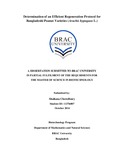Determination of an efficient regeration protocol for Bangladeshi peanut varieties (Arachis hypogaea L.)

View/
Date
2014-10Publisher
BRAC UniversityAuthor
Chowdhury, ShahanaMetadata
Show full item recordAbstract
Peanut is an economically important oilseed crop with high nutrition value. This plant is
imposing several yield constrains like biotic and abiotic stresses. However, fungal diseases are mostly seen. Like other legumes, it has physiological barriers in traditional hybridization in such case “tissue culture regeneration ” offers a potential alternative for improving production in quantity and quality of this plant. Several attempts with various explants have already revealed in past few years but an efficient protocol with case by case study is yet to be revealed for popular Bangladeshi peanut varieties. In this study, the role and interaction of the most promising explant sources; effect of different growth hormones in different combination and concentration have
been investigated for six farmer popular Bangladeshi cultivar to find out an efficient
transformation amenable regeneration protocol of Arachis hypogaea . In this experiment, BAP singly gave indirect regeneration and BAP combined with kinetin gave direct regeneration from leaflet explant, 5 mg/l BAP with and without 0.5 mg/l Kn showed multiple shoots in lower length in case of BARI Chinabadam-7 and BARI Chinabadam-8. However, 2.00 mg/l BAP with and without 0.5 mg/l Kn showed multiple shoots in lower length in case of Dhaka Chinabadam- 1, BINA Chinabadam-2, BINA Chinabadam-4, BINA Chinabadam-6 varieties. The another promising explant half decapitate embryo, gave rapid multiple longer shoots in 3.00 mg/l BAP and 1.00 mg/l Kinetin combined media for most of the cases. Among all the varieties BINA Chinabadam-6 was resulted to be best among all the varieties. At the stage of rooting, three root induction hormone were tried - IBA, IAA, NAA and the concentration was about 0.1 and 0.2 mg/l; among them 0.2 mg/l IBA shows better root formation and highest survival rate at hardening stage. Seasonal impact on rooting was also studied where January to June is the suitable period where September to November, no rhizogenesis was occurred. BINA Chinabadam-4 and BINA Chinabadam-6 gave the higher number of pod formation then the other.
